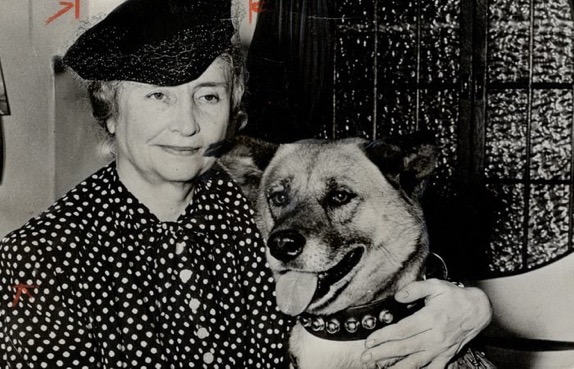
You know that dogs are amazing—but did you also know how fascinating they are? These facts about dogs will give you a new appreciation for our furry friends.

Facts about dogs you never knew
Why, among all the animals on earth, do dogs hold such a special place for us? They’ve been our friends for thousands of years, serving as companions, sentries, warriors, ratters, hunters and lifesavers, and they come in all shapes, sizes and personalities. They are also endlessly fascinating, as any list detailing facts about dogs will prove. And that fascination causes many people, myself included, to devote their lives to a totally different species than their own.
Like most dog lovers, I started out loving dogs because they were cuddly, cute and fun. Then I decided that to really understand them, I needed to learn why dogs behave in certain ways, how they perceive the world and how their genes influence them. I eventually accumulated a houseful of my favourite breed (salukis, in case you were wondering), earned a PhD studying dog senses, and wrote hundreds of articles and 30-plus books about dogs—along the way, storing away loads of random facts about them.
To say that we know everything about dogs would be as ludicrous as to say we know everything about humans. But here, from my 50-plus years of fascination, are 30 facts that will make you appreciate dogs even more and maybe even interact with yours a little differently.

1. Dogs were the first animals domesticated by humans
Fossil evidence indicates that dogs were domesticated around 23,000 years ago and were the only animals domesticated during the Pleistocene Epoch (aka the Ice Age), but DNA evidence places the date even further back. In 2021, a literature review published in PNAS concluded that domestication began in Siberia up to 26,000 years ago. These dogs were derived from a now-extinct species of wolf and migrated around the globe along with their humans. Some of the oldest-known breeds are the Arctic spitz breeds, Middle Eastern sighthounds and several Chinese dog breeds.

2. Dogs are the most diverse mammals on earth
They range in size from tiny Chihuahuas to gargantuan Great Danes, and they come in a huge variety of body types, coat types, coat colours, ear types and even behaviours. But scientists have discovered their diversity is due to a fairly small number of genes that make huge differences in their looks. For example, 90% of all dog coat types are determined by just three genes: long vs. short hair; furnished (facial hair) vs. non-furnished hair; and straight vs. curly hair. Similarly, surprisingly few genes also control how big a dog is, how long its nose is and how its ears are shaped, among other traits.

3. Dogs’ eyes are designed to see in the dark
It’s a little complicated, but here’s the CliffsNotes version of why dogs have excellent night vision:
- Both dogs’ corneas and lenses are more rounded than ours are, which gives them better light collection.
- Their pupils can open wider than ours to let in more light.
- Their retinas (the light-sensitive layer at the back of the eye) are made up mostly of rod cells, which use low light, whereas ours have areas of pure cones, which use bright light.
- And finally, dogs have a layer over their retinas called a tapetum, which reflects light that got past the retina back through the retina from behind. This gives light a second chance at being detected. People don’t have that.

4. About 28,000 dogs compete at the world’s largest dog show every year
That’s a far cry from the first dog show in the world, held in Newcastle-on-Tyne in England in 1859. It attracted 60 entries, all pointers and setters. These days, the largest dog show in the world is Crufts, also in England, and it’s been held since 1891. An estimated 28,000 dogs compete there each year, and it attracts more than 200,000 spectators. That’s a lot of dogs and dog lovers!

5. Dogs can sniff which way you’re walking in five steps
They can tell which way a human scent trail is headed, even if they come across it at right angles—and even if the person walks backward. And studies show their sense of smell is so sensitive that they can tell the difference in scent intensity within just five footsteps (but not three) of the track layer.

6. Dogs can sense the Earth’s magnetic field
In 2020, Czech researchers studied dogs that could find their way back from a hunting excursion using a novel route with a shortcut. They found that the dogs were able to do this by aligning themselves with the Earth’s magnetic field, which acts as a natural GPS of sorts for them. Other research suggests they also align themselves with the Earth’s magnetic field to poop, which is one of the reasons they circle to find the right spot.

7. Several celebrities helped establish dog breeds in America
Zeppo Marx, of the Marx Brothers, brought some of the first Afghan hounds to America from England in 1931. Helen Keller brought the first Akita to the United States from Japan in 1937. And burlesque entertainer Gypsy Rose Lee bred and promoted Chinese crested dogs (you know, the naked ones) starting in the 1950s after her sister found two of these hairless dogs in a shelter. As the story goes, she showed them to Gypsy, who thought it was a perfect match! Nobody knows exactly to what extent having celebrity owners had on these breeds’ popularity, but it almost certainly helped.

8. Dogs have fewer, and different, taste buds than we do
Several things taste different to them. For example, most artificial sweeteners taste bitter, not sweet, which is why your dog rejects them. But there’s one artificial sweetener they may like—and it’s a dangerous one for them. Xylitol (also called birch sugar) is used in many sugarless gums, candies and medicines, and it causes a sudden drastic drop in blood sugar in dogs, which can lead to liver damage and even death.
An added warning about this dog fact: Be on high alert when you have guests over. Xylitol ingestion often occurs when visitors leave candy or gum in their purse—and then leave the purse in a place where a dog can steal it. This is one case where it’s not impolite to tell your guests to leave their candy in the car.

9. Dogs were some of the first action heroes in movies
Rin Tin Tin was called “the dog who saved Hollywood” because his films rescued the struggling Warner Bros. studio from bankruptcy. American soldiers found “Rinty” as a puppy in a foxhole in France and brought him back to the United Sates, where his stunts made him a bona fide animal action hero.
But he wasn’t the first: A decade earlier, another German shepherd named Strongheart was a big-screen idol. And before that, border collies were the early stars. In fact, the first dog to appear in a movie was a border collie named Jean, who starred in the silent 1910 hit Jean Goes Foraging. Other major dog stars have since included Lassie, Benji and Marley—and Toto too!—but only Lassie and Rin Tin Tin have stars on the Hollywood Walk of Fame.

10. A dog’s whiskers are important sensory organs
Technically called vibrissae, a dogs whiskers aren’t just for show—they help a dog sense its surroundings, maintain balance and even use air currents to determine how far people or animals are from them. Anecdotal reports abound that dogs with shaved whiskers tend to get more cuts on their faces due to their absence and have an impaired sense of balance after their whiskers are cut off. However, even though whiskers are classified as sensory organs, they are often clipped during grooming. In some countries, it is actually illegal to cut off a dog’s vibrissae.








